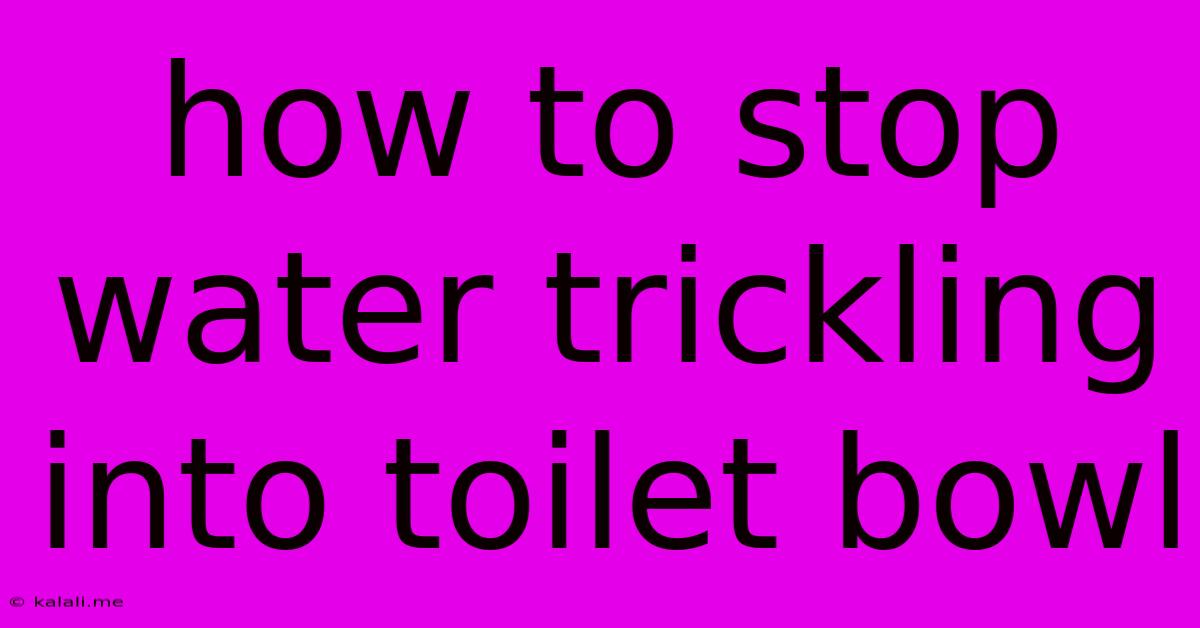How To Stop Water Trickling Into Toilet Bowl
Kalali
May 22, 2025 · 3 min read

Table of Contents
How to Stop That Annoying Trickle: Fixing a Leaky Toilet Bowl
A constant, subtle trickle of water into your toilet bowl might seem insignificant, but it's a major source of water waste and can significantly increase your water bill. Ignoring it can also lead to more serious plumbing problems down the line. This article will guide you through troubleshooting and fixing this common issue, helping you save water and money.
Understanding the Culprit: The Fill Valve and Flapper
The most frequent cause of a consistently trickling toilet is a faulty fill valve or flapper. Let's examine each:
1. The Fill Valve:
The fill valve is responsible for replenishing the water in the tank after each flush. A malfunctioning fill valve can lead to a continuous slow drip into the bowl. Issues include:
- Worn-out seals or gaskets: Over time, these components can wear down, allowing water to seep past.
- Incorrect adjustment: The fill valve's height might be improperly adjusted, causing it to overfill the tank. This excess water then leaks into the bowl.
- Internal valve failure: The internal mechanism of the fill valve might be damaged, preventing it from shutting off completely.
2. The Flapper:
The flapper is a rubber or plastic component that seals the opening at the bottom of the tank. When you flush, the flapper lifts to allow water to flow into the bowl. If it doesn't seal properly, water will continuously trickle into the bowl. Common problems include:
- Deterioration: Years of use and exposure to water can cause the flapper to become brittle, warped, or otherwise damaged, preventing a tight seal.
- Mineral buildup: Hard water deposits can accumulate on the flapper, hindering its ability to create a proper seal.
- Misalignment: The flapper might not be properly aligned with its seat, resulting in a leak.
Troubleshooting and Repairing Your Leaky Toilet
Before starting any repairs, turn off the water supply to the toilet using the shut-off valve located behind the toilet. This is crucial to prevent further water damage.
1. Inspecting the Fill Valve:
- Check for leaks: Carefully observe the fill valve for any signs of water leaking around its connection points or from the valve itself.
- Adjust the height: If the fill valve is too high, adjust it downwards slightly using the adjustment nut. The water level should be about an inch below the overflow tube.
- Check for debris: Examine the fill valve for any debris that might be obstructing its proper function.
2. Inspecting the Flapper:
- Check for warping or damage: Carefully examine the flapper for any signs of damage, such as cracks, tears, or warping.
- Inspect for mineral buildup: Clean the flapper and its seat thoroughly with a toilet bowl cleaner to remove any mineral deposits. A soft brush can help remove stubborn deposits.
- Check alignment: Ensure that the flapper is properly aligned with its seat and is sitting correctly.
Replacing Parts:
If you’ve inspected both the fill valve and the flapper and found damage, replacement is usually the best solution. These parts are readily available at most hardware stores and are relatively inexpensive. Replacement is generally straightforward and involves simply removing the old part and installing the new one according to the manufacturer's instructions. You'll find many helpful video tutorials online demonstrating the process for various toilet models.
Preventing Future Problems:
Regular maintenance can significantly extend the lifespan of your toilet components and prevent leaks. This includes:
- Regular cleaning: Clean your toilet tank periodically to remove mineral buildup and other deposits.
- Checking for leaks: Regularly inspect your toilet for any signs of leaks, paying close attention to the fill valve and flapper.
- Using water-saving devices: Consider installing a low-flow toilet or a water-saving flapper to further reduce water consumption.
By following these steps, you can effectively troubleshoot and repair a leaky toilet bowl, saving water, money, and preventing future plumbing problems. Remember, if you're uncomfortable working with plumbing, it’s always best to call a qualified plumber.
Latest Posts
Latest Posts
-
Turn Red As A Chili Pepper
May 22, 2025
-
3 Phase To 1 Phase Transformer
May 22, 2025
-
How To Clean Cement Off Brickwork
May 22, 2025
-
Why Are My Bonded Cats Fighting
May 22, 2025
-
Y Square Root Of X Graph
May 22, 2025
Related Post
Thank you for visiting our website which covers about How To Stop Water Trickling Into Toilet Bowl . We hope the information provided has been useful to you. Feel free to contact us if you have any questions or need further assistance. See you next time and don't miss to bookmark.